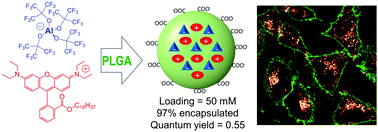当前位置:
X-MOL 学术
›
Mater. Chem. Front.
›
论文详情
Our official English website, www.x-mol.net, welcomes your feedback! (Note: you will need to create a separate account there.)
An aluminium-based fluorinated counterion for enhanced encapsulation and emission of dyes in biodegradable polymer nanoparticles
Materials Chemistry Frontiers ( IF 7 ) Pub Date : 2017-08-15 00:00:00 , DOI: 10.1039/c7qm00248c Bohdan Andreiuk 1, 2, 3, 4, 5 , Andreas Reisch 1, 2, 3, 4, 5 , Vasyl G. Pivovarenko 6, 7, 8, 9, 10 , Andrey S. Klymchenko 1, 2, 3, 4, 5
Materials Chemistry Frontiers ( IF 7 ) Pub Date : 2017-08-15 00:00:00 , DOI: 10.1039/c7qm00248c Bohdan Andreiuk 1, 2, 3, 4, 5 , Andreas Reisch 1, 2, 3, 4, 5 , Vasyl G. Pivovarenko 6, 7, 8, 9, 10 , Andrey S. Klymchenko 1, 2, 3, 4, 5
Affiliation

|
Dye-loaded polymer nanoparticles, due to their high brightness and potential biodegradability, emerge as a powerful alternative to quantum dots in bioimaging applications. To minimize aggregation-caused quenching of the loaded dyes, we have recently proposed the use of cationic dyes with bulky hydrophobic counterions (also known as weakly coordinating anions), which serve as spacers preventing dye pi-stacking inside nanoparticles. However, so far this approach of counterion-enhanced emission inside polymer NPs has been limited to one fluorinated tetraphenylborate (tetrakis(pentafluorophenyl)borate, F5-TPB). Herein, we show that the counterion-enhanced emission approach is not limited to tetraphenylborates and can be extended to other types of anions, such as the aluminium-based anion, Al[OC(CF3)3]4− (F9-Al), which is much easier to scale up, compared to F5-TPB. It is found that F9-Al strongly improves the encapsulation efficiency of the octadecyl rhodamine B dye compared to the perchlorate counterion (97 ± 2 vs. 51 ± 2%), being slightly better than F5-TPB (92 ± 4%). Similarly to F5-TPB, F9-Al can effectively prevent aggregation-caused quenching of rhodamine inside NPs made of the biodegradable polymer, poly(lactide-co-glycolide) (PLGA), even at 50 mM dye loading. According to single-particle microscopy, the obtained NPs are 33-fold brighter than commercial quantum dots QD585 at 532 nm excitation and exhibit complete ON/OFF switching (blinking), as was originally observed for NPs based on F5-TPB. Importantly, NPs loaded with the rhodamine/F9-Al ion pair entered the cells by endocytosis, showing no signs of dye leaching, in contrast to rhodamine perchlorate, which exhibited severe leakage from NPs with characteristic accumulation inside mitochondria. Moreover, F9-Al surpassed the F5-TPB anion in stability of dye-loaded NPs against leaching, which can be attributed to the higher hydrophobicity of the former. Overall, this work shows that counterion-enhanced encapsulation and emission of cationic dyes inside polymer NPs is a general approach for the preparation of stable and highly fluorescent nanomaterials for bioimaging applications.
中文翻译:

铝基氟化抗衡离子,用于增强可生物降解的聚合物纳米颗粒中染料的包封和发射
负载染料的聚合物纳米颗粒由于其高亮度和潜在的生物降解性,在生物成像应用中成为量子点的有力替代品。为了最大程度地减少聚集引起的负载染料的猝灭,我们最近提出了使用带有庞大疏水性抗衡离子(也称为弱配位阴离子)的阳离子染料,它们可作为间隔物,防止染料pi堆积在纳米粒子内部。但是,到目前为止,这种聚合物NP内部抗衡离子增强发射的方法仅限于一种氟化四苯基硼酸酯(四(五氟苯基)硼酸酯,F5-TPB)。在此,我们表明抗衡离子增强发射法不限于四苯基硼酸酯,还可以扩展到其他类型的阴离子,例如铝基阴离子Al [OC(CF 3)3] 4 −(F9-Al),与F5-TPB相比,它更易于放大。发现与高氯酸根抗衡离子相比,F9-Al大大提高了十八烷基若丹明B染料的包封效率(97±2对51±2%),比F5-TPB(92±4%)略好。类似于F5-TPB,F9-Al系可以有效地防止内部制成可生物降解的聚合物,聚的NP罗丹明的聚集引起的淬灭(丙交酯-共-乙交酯)(PLGA),即使在染料负载量为50 mM的情况下也是如此。根据单粒子显微镜,所获得的NP在532 nm激发下比商业量子点QD585亮33倍,并且显示出完全的ON / OFF切换(闪烁),如最初基于F5-TPB的NP所观察到的。重要的是,装有罗丹明/ F9-Al离子对的NPs通过内吞作用进入细胞,没有显示出染料浸出的迹象,与罗丹明高氯酸盐相反,后者从线粒体内具有特征性积累的NPs泄漏严重。此外,F9-A1在负载染料的NPs的抗沥滤稳定性方面超过了F5-TPB阴离子,这可以归因于前者的较高疏水性。全面的,
更新日期:2017-10-26
中文翻译:

铝基氟化抗衡离子,用于增强可生物降解的聚合物纳米颗粒中染料的包封和发射
负载染料的聚合物纳米颗粒由于其高亮度和潜在的生物降解性,在生物成像应用中成为量子点的有力替代品。为了最大程度地减少聚集引起的负载染料的猝灭,我们最近提出了使用带有庞大疏水性抗衡离子(也称为弱配位阴离子)的阳离子染料,它们可作为间隔物,防止染料pi堆积在纳米粒子内部。但是,到目前为止,这种聚合物NP内部抗衡离子增强发射的方法仅限于一种氟化四苯基硼酸酯(四(五氟苯基)硼酸酯,F5-TPB)。在此,我们表明抗衡离子增强发射法不限于四苯基硼酸酯,还可以扩展到其他类型的阴离子,例如铝基阴离子Al [OC(CF 3)3] 4 −(F9-Al),与F5-TPB相比,它更易于放大。发现与高氯酸根抗衡离子相比,F9-Al大大提高了十八烷基若丹明B染料的包封效率(97±2对51±2%),比F5-TPB(92±4%)略好。类似于F5-TPB,F9-Al系可以有效地防止内部制成可生物降解的聚合物,聚的NP罗丹明的聚集引起的淬灭(丙交酯-共-乙交酯)(PLGA),即使在染料负载量为50 mM的情况下也是如此。根据单粒子显微镜,所获得的NP在532 nm激发下比商业量子点QD585亮33倍,并且显示出完全的ON / OFF切换(闪烁),如最初基于F5-TPB的NP所观察到的。重要的是,装有罗丹明/ F9-Al离子对的NPs通过内吞作用进入细胞,没有显示出染料浸出的迹象,与罗丹明高氯酸盐相反,后者从线粒体内具有特征性积累的NPs泄漏严重。此外,F9-A1在负载染料的NPs的抗沥滤稳定性方面超过了F5-TPB阴离子,这可以归因于前者的较高疏水性。全面的,


























 京公网安备 11010802027423号
京公网安备 11010802027423号